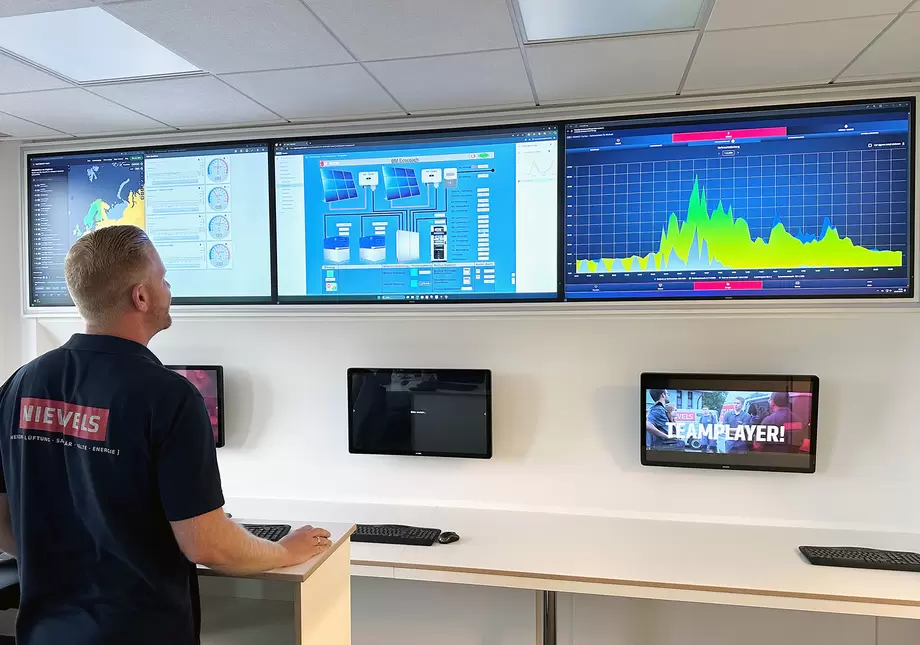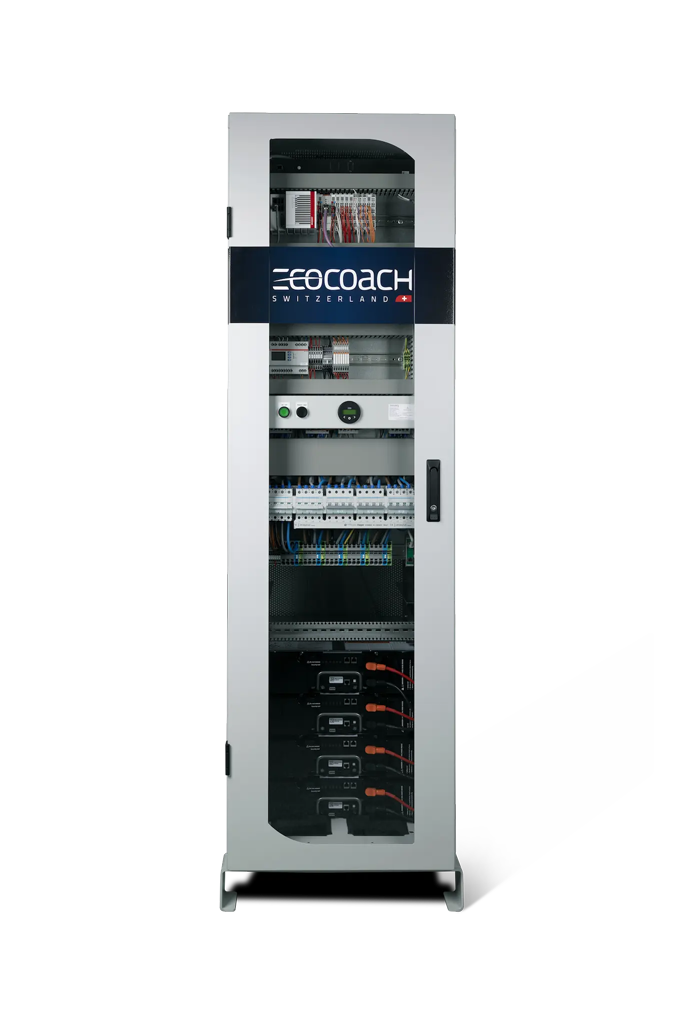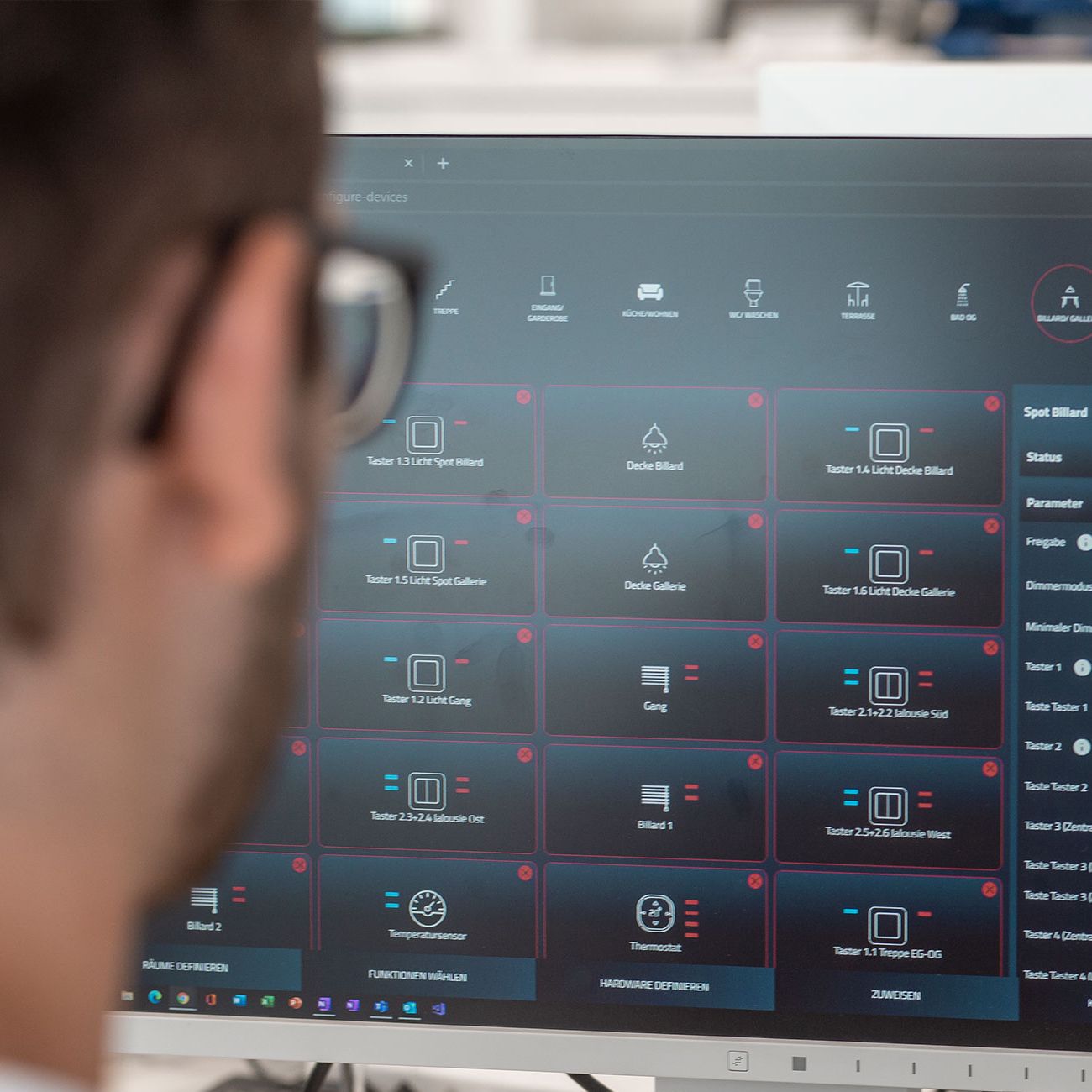


Expand your energy supply sustainably, self-sufficient and securely
from 26-390 kWh capacity, 13-144 kVA output, three-phase with integrated inverter and real emergency power
Swiss energy management for a complete smart building solution
Directly connected: PV systems, combined heat and power plants, heat pumps, water treatment, electromobility, meters, etc.
Intuitive software for installers, operations management, property management and end users
The ecoBatterySystem is both an electricity storage system and an energy centre. As one of the few battery systems on the market, it combines all relevant use cases:
Self-consumption optimization, load management, peak load capping, and genuine 3-phase power replacement in case of a power failure or blackout make the storage system ideal for large single-family homes with large power requirements, multi-family properties, commercial and industrial buildings, entire building areas, and farms.

The ecoEnergyCoach energy management system (EMS) integrated into the battery storage system does not only cover the electrical side. All components for heat, water, and, for example, gas are coordinated across sectors. A holistic energy infrastructure design ensures economical, safe and sustainable operation.
The system enables intuitive Commissioning for installers and isolators. Operations and property management can optimize and read out billing data. End users can view all their monitoring data via the app and, for example, quickly approve charging stations for electric vehicles

Control for maximum total power

Control of the maximum current per phase

Establishment of building netzwork and short-termin supply with stored batter capacity

Development of the building network and activation of existing generators (PV, CHP, etc.) for the supply of buildings

Combination of self-consumption optimization, peak load capping, load management and emergency power

Fine-tuned control of consumers for precise adjustment of the currently used power

Control of defined power levels or on/off control of consumers

Activation/deactivation and power control of PV, CHP and other generators in emergency power mode
| Basic specifications | Integrated inverter, NA protection, circuit breaker |
|---|---|
| System topology | AC-coupled system, stitch or series |
| Connections | 4 x 230 Volt / 400 Volt AC, 50 Hz, max. 63 A (to be defined when ordering), RJ45 for Internet connection, the cable entry and connections are positioned at the bottom |
| Optional interfaces Energy management |
|
| Optional electromobility interface |
|
| Charging and discharging power Inverter | Up to 24 kW |
| Inverter efficiency | Max. 96 % |
| Cooling principle | Air-cooled |
| Cascading | Primary and secondary function for up to six systems with a total capacity of 390 kWh |
| Further functions | Emergency power, mains backup and grid-forming stand-alone operation |
| Measurement | Separate power measurement per connection, expandability with external measuring points |
| Display | Display battery charge status, operating mode, temperature, system status |
| Control ecoBatteryModule | CAN bus |
| Battery capacity | Min. 4, max. 10 ecoBatteryModules, with a capacity of 6.5 kWh gross and 5.85 kWh net, total capacity max. 65 kWh gross, respectively 58.5 kWh net |
| Storage technology | LG Chem EM048126P357, cell type LiNiMnCo02, 48 Volt DC, efficiency of 95%, C-rate 0.5, temperature range 0°C to 45°C, modules comply with standard IEC 62619 and UN38.3 tests |
| Protection class | IP20 |
| Standards and directives | CE | IEC 62477-1:2012 Ed 1.0 | IEC 62619 Ed 1.0 | VDE-AR-E 2510-50:2017 | VDE-AR-N 4105:2018-11 | TOR generator type A | OVE guideline R 25 | EN 61000-6-2:2005 | EN 61000-6-3:2007 + A1:2011 + AC:2012 | DIN EN IEC 62040-2:2019-04 |
| Operating temperature range | 0 °C to 45 °C, humidity 5 to 80 % (non-condensing) |
| Dimensions (WxHxD) | ecoBatterySystem: 63 x 207 x 83 cm |
| Weight (empty weight without ecoBatteryModule) | 324 kg max. (depending on the inverter version), additional weight per ecoBattery module 44 kg, the base area suitable for transport using a pallet truck |
| Control, monitoring and visualisation | Via the ecocoach app (browser and mobile) |
| Commissioning and maintenance | Via ecoSetupTool, Internet connection via Ethernet (RJ45) required, push messages in the event of alarms or faults |
Yes, support measures exist in Switzerland, but they vary from canton to canton and from municipality to municipality.
This list shows which support measures apply in Switzerland. It is not exhaustive, and the information provided is not guaranteed.
The following energy generators are heat pumps, PV, CHP, hydroelectric power plants, and wind.
The following energy consumers: heating elements, charging stations for electromobility, ventilation, and air conditioning.
In the event of a power outage, the company's own power grid will continue to be maintained, and the connected consumers will continue to be supplied with electricity. This increases additional security of supply and independence from the public power grid.
With a battery storage system, the energy produced can be temporarily stored and called up later if necessary. This increases self-consumption, less electricity is fed back into the grid, and less electricity is drawn from the grid. This increases independence from electricity prices. Further advantages can be extended with additional options: emergency power capability, multi-use, additional energy management functions, etc.
The profitability depends on various factors, such as the current electricity price, recovery tariff, electricity products, etc.
However, a battery storage system has the additional added value that should also be taken into account: emergency power capability, increased energy supply security, energy management functions, etc.
